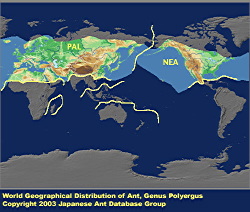
|
genus
|
Polyergus
|
 |
Japanese Name
|
Samurai-ari-zoku
|
Original Reference
|
|
Latreille, P.A. (1804) Tableau m?thodique des insectes. Classe huiti?me. Insectes, Insecta. Nouveau Dictionnaire d'Histoire Naturelle 24: 129-200.
|
Description
|
|
Workers monomorphic, total length about 5 to 10 mm. Eyes and ocelli prominent, as in Formica. Antennae short, 12-segmented. Anterior margin of clypeus almost straight, never protruding in the middle. Mandibles sickle-shaped, without distinct denticles. Maxillary palpi 4-segmented, labial palpi 2-segmented; both sets short. Mesosoma stout. Promesonotal suture and metanotal groove distinct. Propodeum slightly raised. Petiole thick, its summit rounded in lateral view. Body color black in P. samurai Yano and P. nigerrimus Marikovski, reddish in the other species.
|
|

|
Remarks
|
|
Polyergus workers are similar to those of Formica in size and thoracic morphology, but distinguished by the morphology of the clypeus, mandibles and petiole etc. Females are winged and not much larger than workers. The occurrence of apterous ergatogynes as well as normal queens is known in the European species P. rufescens (Latreille). Males are smaller than workers: frontal area absent; mandible small, straight and acute; antennae very short. Subgenital plate small and simple.
|
Editor
|
|
Original text by Rikio Sonobe, Kazuo Ogata and Keiichi Onoyama. English translation by Keiichi Onoyama, edited by Robert W. Taylor. Revised by Masashi Yoshimura.
|
|